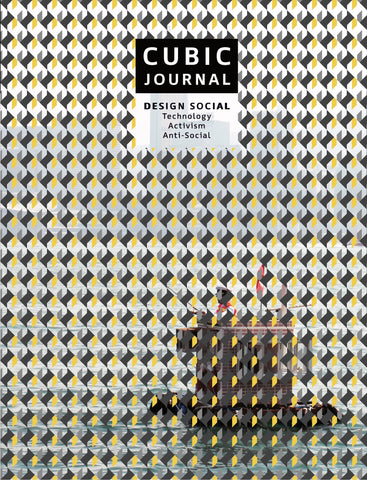Your cart is currently empty!
CUBIC JOURNAL issue #1 DESIGN SOCIAL
+++Technology - Activism - Anti-Social+++
+++Gerhard Bruyns & Peter Hasdell [red]+++
978-94-92852-05-2
Gabrielle Lai and Markus Wernli
216
20 x 26.5 cm / 7.87 x 10.43 inch
Paperback
Engels
Tekstredacteur: Shannon Ross - Make No Bones Studio, Hong Kong
Verschijningsdatum: Spring/Summer 2018
ISSN 2589-7090 (print) ISSN 2589-7101 (online)
Een uitgave van Jap Sam Books in samenwerking met The Hong Kong Polytechnic University, Environmental & Interior Design, School of Design. Uitgegeven met ondersteuning van The School of Design, The Hong Kong Polytechnic University en The Cubic Research Network.
Cubic Journal is een uitgave van Cubic Society en de Cubic Research Network.
+++
The inaugural issue of Cubic Journal questions the conditions of design-social in a wide range of different disciplines, groups,and stakeholders,in dynamic communities of practice that can lead design beyond its mere capabilities of synthesis into new forms of a social design praxis,whereby design is co-dependent on synthesis as well as analytic practices.
The emergence of social media and the networked society, as exemplified by (but not limited to) the Internet of things, generates enormous potentialsthat reposition design as a means to synthesise emerging social complexities into new constellations. These have the capacity to foster new social forms and social design as a knowledge field in its own right.
One of the ways design in this context becomes reconfigured is as the dynamic interconnections betweenpeople, practices and artefacts, in which the interactions lead to relational rather than objectified forms of design. Such approaches tend to be process driven rather than outcome based and activate design’s potential within both knowledge generation and knowledge transfer processes - that can be understood as ‘information’ or as design before design and design after design. Often misconstrued as purely a design approach, participatory design is,in fact,a rigorous research methodology involving a complex system of knowledge generation and co-design processes where the interactions of people, design artefacts, technologies, practices (activism) and knowledge, steers a course between participants’ tacit knowledge and the designer-researchers’analytical or technical knowledge. Design in this context is a complex mesh of tangible and intangible factors, (anti) socialforms and networks, information, contexts,and people, able to frame design processes and praxis that are adaptable for inter-disciplinary collaboration (horizontal); and for user and designer collaboration (vertical).
Contributors to this issue include: Arie Graafland, Khaya Mchunu & Kim Berman, Gerhard Bruyns, Kacey Wong, Luke Tipene, Patrick Healy, Simone AbudMaliq Simone, Marko Stanojevic, Peter Hasdell, Jamie, Hanna Wirmanand Lukáš Likavčan.
Technology - Activism - Anti-Social
€25.00
CUBIC JOURNAL issue #1 DESIGN SOCIAL
Technology - Activism - Anti-Social
€25.00
Bookazines / serie / Vormgeving / Theorie
978-94-92852-05-2
Gabrielle Lai and Markus Wernli
216
20 x 26.5 cm / 7.87 x 10.43 inch
Paperback
Engels
Tekstredacteur: Shannon Ross - Make No Bones Studio, Hong Kong
Verschijningsdatum: Spring/Summer 2018
ISSN 2589-7090 (print) ISSN 2589-7101 (online)
Een uitgave van Jap Sam Books in samenwerking met The Hong Kong Polytechnic University, Environmental & Interior Design, School of Design. Uitgegeven met ondersteuning van The School of Design, The Hong Kong Polytechnic University en The Cubic Research Network.
Cubic Journal is een uitgave van Cubic Society en de Cubic Research Network.
The inaugural issue of Cubic Journal questions the conditions of design-social in a wide range of different disciplines, groups,and stakeholders,in dynamic communities of practice that can lead design beyond its mere capabilities of synthesis into new forms of a social design praxis,whereby design is co-dependent on synthesis as well as analytic practices.
The emergence of social media and the networked society, as exemplified by (but not limited to) the Internet of things, generates enormous potentialsthat reposition design as a means to synthesise emerging social complexities into new constellations. These have the capacity to foster new social forms and social design as a knowledge field in its own right.
One of the ways design in this context becomes reconfigured is as the dynamic interconnections betweenpeople, practices and artefacts, in which the interactions lead to relational rather than objectified forms of design. Such approaches tend to be process driven rather than outcome based and activate design’s potential within both knowledge generation and knowledge transfer processes - that can be understood as ‘information’ or as design before design and design after design. Often misconstrued as purely a design approach, participatory design is,in fact,a rigorous research methodology involving a complex system of knowledge generation and co-design processes where the interactions of people, design artefacts, technologies, practices (activism) and knowledge, steers a course between participants’ tacit knowledge and the designer-researchers’analytical or technical knowledge. Design in this context is a complex mesh of tangible and intangible factors, (anti) socialforms and networks, information, contexts,and people, able to frame design processes and praxis that are adaptable for inter-disciplinary collaboration (horizontal); and for user and designer collaboration (vertical).
Contributors to this issue include: Arie Graafland, Khaya Mchunu & Kim Berman, Gerhard Bruyns, Kacey Wong, Luke Tipene, Patrick Healy, Simone AbudMaliq Simone, Marko Stanojevic, Peter Hasdell, Jamie, Hanna Wirmanand Lukáš Likavčan.



